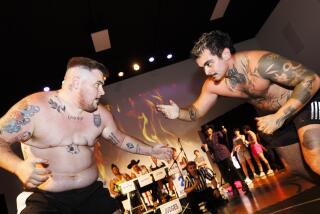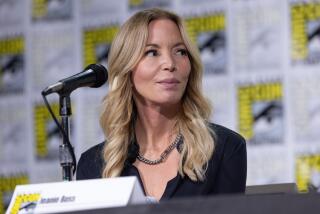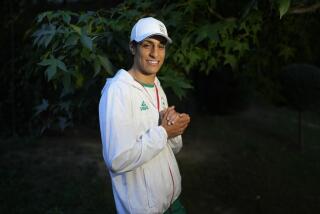WWE just got its first Arab woman in the ring, and she’s ready to rumble

Shadia Bseiso is training to become the Arab world’s first professional female wrestler.
- Share via
Reporting from Dubai, United Arab Emirates — Shadia Bseiso, a Dubai-based TV host and voice artist, is a CrossFit aficionado and Jiu Jitsu blue belt holder. (“It’s a grappling sport; no black eyes.”)
Viewers in Dubai know her mainly for hosting widely televised regional sporting events, but they’re about to see a new side. Come January, she’ll join the incoming class of World Wrestling Entertainment (WWE) hopefuls, ready to rumble as the Arab world’s first professional female wrestler.
Her enrollment at WWE’s Performance Center, the group’s official training school in Orlando, Fla., is the end of a journey that began in January, when Bseiso, 31, was invited to participate in auditions to be an announcer for the WWE’s first Arabic offering, Wal3ooha (a Latinized rendering of an Arabic word that means “light it up”).
Somewhere in her interview, Bseiso said, she began to talk about much she enjoyed martial arts — “and that if I wasn’t a full-time [announcer] I would be a full-time athlete.”
That pushed Canyon Ceman, WWE’s senior vice president of international talent development, to offer her a spot in athlete tryouts held earlier this year in Dubai. Bseiso was the only one among 33 other competitors — seven of them women — who wasn’t a full-time athlete.
Over four days, Bseiso and those with her ran drills for hours, performed moves before a crowd and tested their performing chops in “promo” classes, where would-be wrestlers learn to hone their character.
“On the fourth day, just before we all went home, Matt Bloom [WWE’s head trainer] pulled me aside and said, ‘Are you ready to move to the U.S.?’”
At first, Bseiso only told her sister, Arifa.
“How [do you] tell your parents you want to be the next WWE superstar? You don’t tell them except in person,” Bseiso said. She added that they were “extremely supportive” when she did finally tell them.
Growing up in Jordan, Bseiso had only a passing knowledge of WWE, where she would occasionally see matches broadcast on television or on tapes from video rental stores.
But by the time the WWE tryout had come to Dubai, she had made a name for herself hosting major sporting events like “Desert Force,” a mixed martial arts tournament.
Part of her passion came from her parents, who treated the Bseiso children (three sisters and a brother) as equals and inculcated in them the discipline to excel. Shadia isn’t the family’s first athlete: Arifa is a boxer who recently became one of Nike’s brand ambassadors in the Middle East.
Bseiso’s hiring comes at a time when WWE is mounting a full-scale expansion into markets outside the U.S. and Europe. In 2016, Ceman said, the focus was on China. This year it was the Middle East.
“You see the metrics on social media, and you find we have something like 11 million Facebook followers in Egypt. That’s stuff that makes you go, ‘What? Really?”’ said Ceman.
That global push has extended to WWE’s growing roster of athletes. One of the reasons for the tryout in the Middle East was to provide characters whom wrestling’s “surprisingly ethnically large and diverse audience … can identify with,” Cemen said.
“We’re looking for size, charisma, work ethic, diversity, language, country of origin … and we train them as sports entertainers from zero,” he said.
At the Performance Center, candidates spend three hours of in-ring and technical-skill training, then an hour and a half of conditioning and an hour of acting class. There also are anywhere from three to six live events every weekend.
There’s no guarantee new recruits will ever make it to the WWE roster, Ceman said, but the grueling schedule compresses roughly 10 years of work experience into about a third of that time.
So far, Bseiso is reveling in the work.
“I spend the whole day in my gym when I’m on my day off. Now it’s my job. That’s something I love,” she said.
She demurred from discussing plans for her character, though she joked that her friends are convinced she’ll “never play the villain.”
“I can’t wait to see what the reaction will be,” she said.
She also knows there’s a lot at stake in getting her character right.
In the past, WWE wasn’t known for the most flattering portrayals of Middle Eastern characters.
During the 1980s, the so-called golden era of wrestling featured stereotypical villains such as the Iron Sheikh (aka the Iranian-born Hussein Khosrow Ali Vaziri) or General Adnan (real name Adnan Kaissie, an Iraqi wrestler who took down Andre the Giant in Baghdad in 1971).
They would square off against all-American figures such as Hulk Hogan, with story lines that often revolved around the 1979 Iranian hostage crisis.
“Now you neither want to nor can you get away with that so easily,” Cemen said. “There is evolving complexity over how to portray someone’s cultural heritage in a way that it is respected, interesting and creates love or animosity in the audience.”
“Shadia has to make a character that will get a reaction, and it’s our writers job to make sure it’s not offensive even while being subtle, culturally sensitive, intelligent and interesting.”
As WWE’s first Arab woman, Bseiso said she feels a sense of responsibility.
“It’s something I don’t take lightly,” she said.
“I don’t know wrestling yet, but I’m going to be as good as I can be,” she added. “I’m in this to headline Wrestlemania. I want it all.”
Bulos is a special correspondent.
Twitter: @nabihbulos
More to Read
Sign up for Essential California
The most important California stories and recommendations in your inbox every morning.
You may occasionally receive promotional content from the Los Angeles Times.











